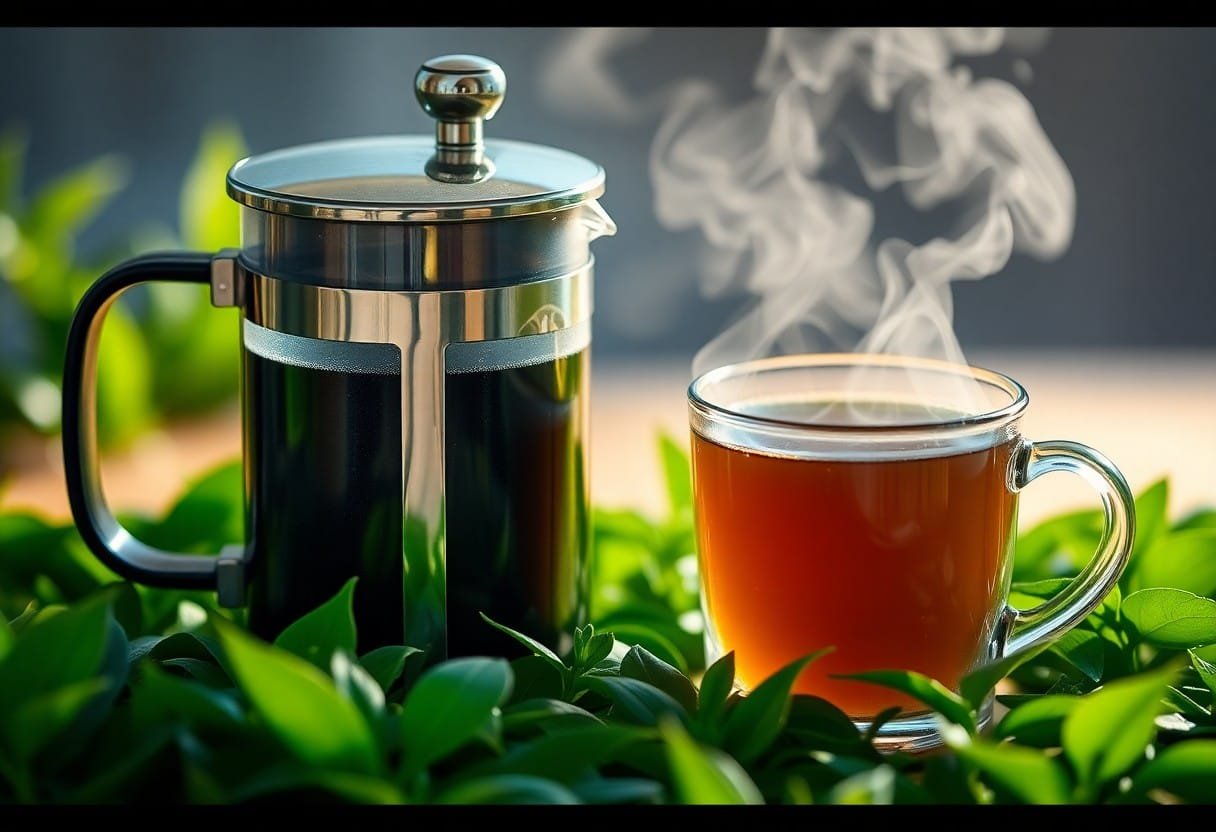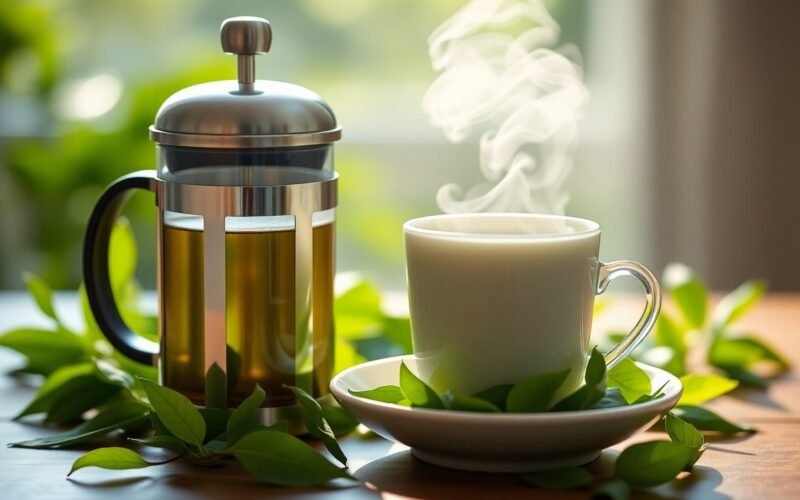The Art of Brewing: French Press Meets Green Tea
Brewing green tea in a French press might seem unconventional, yet it opens up a world of flavor and aroma you wouldn’t expect. Begin by using high-quality loose leaf green tea, opting for approximately 1 to 2 teaspoons for every 8 ounces of water. Let your water cool down to 160-180°F, as this temperature range is ideal for avoiding the bitterness that over-extracted green tea can possess. After steeping for about 2 to 3 minutes, gently press the plunger to separate the leaves from the liquid. This method preserves the tea’s delicate flavors while enhancing its complex profile, allowing you to truly experience the magic that occurs when green tea meets a French press.
Key Takeaways:
- Combining French press brewing with green tea unlocks unique flavor profiles, enhancing the natural sweetness and vegetal notes of the tea.
- The French press method allows for better control over steeping time and temperature, contributing to a richer tea experience without bitterness.
- Experimenting with different green tea varieties and steeping techniques can lead to personalized and delightful brews tailored to individual tastes.
The Science Behind Flavors and Extraction
Understanding the intricate relationship between flavors and the extraction process illuminates why your green tea experience is transformed in a French press. Brewing techniques significantly affect the release of flavors, aromas, and vital nutrients. The French press method, with its immersion brewing style, allows your green tea leaves to fully express their potential, leading to a deeper and more vibrant taste profile that you can genuinely appreciate.
Chemical Properties of Green Tea
Green tea is rich in polyphenols, particularly catechins, which are powerful antioxidants. These compounds are responsible for the unique flavors and health benefits associated with green tea. The specific catechins, like epigallocatechin gallate (EGCG), deliver a subtle astringency and umami, which are heightened through appropriate brewing methods, emphasizing the delicate balance of sweet and bitter notes in your cup.
Why French Press Enhances Tea Experience
The French press elevates your green tea experience by maximizing immersion and contact between water and tea leaves. This method allows for enhanced extraction of vital oils and flavor compounds, leading to a richer and more complex brew. Unlike traditional steeping methods, the French press lets you control steeping time, ensuring that you extract the desired flavors without over-brewing.
Moreover, the design of the French press maintains a constant temperature throughout the brewing process, which is vital for green tea. Optimal temperature helps prevent the release of overly bitter compounds, while promoting the extraction of sweet and grassy notes. The ability to customize steeping duration further caters to your taste preference, enabling you to discover the perfect balance. Notably, the act of pressing down the plunger also results in a uniquely textured brew, transforming a simple cup into an experience that dances harmoniously on your palate.
The Brewing Process: A Step-by-Step Guide
| Step | Description |
|---|---|
| 1. Gather Your Ingredients | Select high-quality green tea leaves and fresh water. |
| 2. Measure Tea | Use approximately 1 teaspoon of loose leaves per 8 ounces of water. |
| 3. Heat Water | Bring your water to a temperature between 160°F and 180°F (70°C to 80°C). |
| 4. Combine | Add the tea leaves to the French press and pour hot water over them. |
| 5. Steep | Allow the tea to steep for 2-3 minutes, adjusting to taste. |
| 6. Press and Serve | Slowly push down the plunger and pour your brewed tea. |
Leaf Selection and Preparation
Selecting the right green tea leaves is paramount for achieving the best flavor. Opt for high-quality loose leaves over tea bags, as the latter often contain dust or broken leaves that compromise taste. Look for vibrant, fragrant leaves with a tender texture. Before brewing, gently rinse the leaves to remove any impurities and awaken their flavors. Proper preparation enhances your brewing experience and ensures fresh, vibrant results in your cup.
Timing and Temperature: The Perfect Balance
Finding the sweet spot in water temperature and steeping time can dramatically alter your green tea’s flavor profile. Water should be heated between 160°F and 180°F (70°C to 80°C), as higher temperatures can lead to a bitter brew. Steeping for 2-3 minutes allows the leaves to unlock their delicate flavors without becoming overly tannic. Adjusting these variables to suit your palate can lead to a personalized, flavorful cup.
| Temperature | Impact on Flavor |
|---|---|
| Below 160°F (70°C) | May result in under-extraction, leading to weak flavors. |
| 160°F – 180°F (70°C – 80°C) | Ideal range for balanced extraction, promoting sweetness and aroma. |
| Above 180°F (80°C) | Can extract bitterness, diminishing the green tea’s delicate notes. |
| Steeping Time | Flavor Outcome |
|---|---|
| Less than 2 minutes | Weak, underdeveloped flavors with minimal aroma. |
| 2-3 minutes | Balanced, well-rounded flavor with aromatic profiles. |
| More than 3 minutes | Over-extraction, leading to bitterness and astringency. |

Taste Testing: Comparing Infusions
As you investigate the world of French press green tea, it’s time to assess how different brews stand up in terms of flavor and aroma. Each green tea variety offers unique characteristics that can be amplified or toned down by the brewing method. A systematic taste testing will allow you to appreciate the nuances each type of green tea brings to the table. You can explore more about using a French press for tea in this Can You Use French Press for Tea (Brewing Guide).
Flavor Profiles of Different Green Teas
Every green tea you choose has its own personality, influenced by factors such as the region, cultivation, and processing methods. Sencha brings out a vibrant grassy flavor with umami undertones, while matcha delivers a creamy texture and a subtle sweetness. Varieties like Dragon Well present a sweet, nutty profile, contrasted by the floral notes found in jasmine green tea. Gunpowder offers a bold, smoky experience, making each tasting session unique and educational.
How Brewing Method Changes Taste
The brewing method plays a significant role in the final flavor profile of your green tea. Different techniques can yield contrasting results, even with the same tea variety. When using a French press, the tea leaves are steeped in hot water for an extended period, allowing for maximum extraction of flavors and aromas. However, this could lead to over-extraction if not timed properly, which may result in bitterness. Other methods, like steeping in a teapot, often produce a softer, more delicate brew.
By utilizing the French press for brewing green tea, you allow the leaves to fully unfurl and release imperative oils, resulting in a more robust infusion. This extraction style accentuates the natural characteristics of the tea, showcasing its unique flavor notes. For example, a quick steep might yield a more vegetal taste for sencha, while a longer infusion allows the nutty sweetness of Dragon Well to shine. Thus, experimenting with steeping times and exploring the interplay between green tea varieties and the French press method can lead to exciting discoveries in your tea journey.
Beyond the Cup: Health Benefits of Green Tea and French Press
The combination of green tea and French press brewing introduces a delightful blend of flavor and wellness benefits. While many enjoy this unique method at home, discussions around its advantages are thriving online. Check out this conversation on Does anyone else use a French press for tea? to see how others incorporate this technique into their everyday routine.
Antioxidants and Their Impact
Through French press brewing, you maximize the release of antioxidant compounds from green tea, such as catechins, which are known for their anti-inflammatory properties. These antioxidants work to combat oxidative stress and support cellular health, contributing to an array of benefits, including enhanced metabolism and improved heart health. Integrating green tea into your daily routine, especially using a French press, allows you to harness these powerful nutrients effectively.
Breathing New Life into Morning Rituals
Infusing your morning routine with green tea brewed in a French press not only elevates the flavor but also enriches your overall health journey. This method can transform mundane mornings into flavorful experiences. As you adjust grind sizes and steep times, you’ll appreciate how each adjustment can lead to unique flavor profiles and enhanced health benefits.
Incorporating a French press into your breakfast ritual expands your options beyond traditional coffee, promoting hydration and nourishment from the get-go. You can experiment with different green tea varieties, playing with loose leaves to discover your personal favorites. Each cup brewed becomes a personal journey, embracing multiple health benefits while refreshing your mornings. The act of preparing your tea becomes a meditative experience, making every sip count in your commitment to wellness.
Creative Innovations: Recipes Beyond Traditional Brews
Exploring creative innovations with green tea and French press opens a world of delicious possibilities. You can elevate the classic brew by incorporating herbs, fruits, and spices for a tantalizing spin on traditional infusions. Check out this resource on Using french press for tea brewing? to discover a variety of recipes that combine unexpected flavors while ensuring a simple brewing process.
Infused Green Tea Variations
Infuse your green tea with vibrant flavors by adding fruits like peach slices or strawberries to your French press. A sprinkle of fresh mint or basil enhances the refreshing nature of the tea, creating a delightful thirst-quencher. You can also experiment with citrus peels for an extra zing, turning your traditional brew into an invigorating experience.
Pairing Suggestions for Culinary Delights
Your French press green tea pairs wonderfully with a variety of culinary delights. The delicate flavors of green tea complement dishes such as sushi, light salads, and grilled fish. Consider sweet options too; matcha-infused desserts or matcha brownies create a beautiful harmony with the earthy notes from your tea. Pairing them creates a sophisticated dining experience that is both harmonious and memorable.
Enhancing your meal with the right pairings amplifies the enjoyment of both food and beverage. For instance, serving your green tea blend alongside a fresh cucumber and avocado sushi roll creates a delicious contrast, highlighting the umami flavors in both. Similarly, light desserts like lemon sorbet or green tea mousse bring out the subtle bitterness and sweetness of your brewed tea. Whether you’re hosting a tea party or enjoying a quiet evening, thoughtful pairings greatly enhance the overall tasting experience.
Conclusion
So, when your French press meets the enchanting world of green tea, you unlock a unique brewing experience that enhances both flavor and health. You have the opportunity to explore the rich, subtle notes of your green tea as the immersion method brings out its natural essence. By mastering this technique, you elevate your tea ritual, inviting a delightful blend of convenience and sophistication into your daily routine. Enjoy the benefits of perfectly brewed green tea, and savor every calming sip it offers.
FAQ
Q: What is the best way to prepare green tea using a French press?
A: To prepare green tea with a French press, start by heating water to about 175°F (80°C), as boiling water can scorch the delicate leaves. Measure approximately one teaspoon of loose green tea per cup of water. Add the tea leaves into the French press, then pour the heated water over them. Allow the tea to steep for 2 to 3 minutes, depending on your desired strength. Once steeped, press the plunger down slowly to separate the leaves from the liquid, and serve immediately for the best flavor.
Q: Can I mix different types of green tea in a French press?
A: Yes, mixing different types of green tea can create a unique flavor profile! Start by blending small amounts of various green tea leaves in the French press and experiment with steeping times. Different teas may have different optimal steeping conditions, so it’s helpful to keep notes on how each combination turns out. Be mindful of balancing flavors; for instance, combining a more robust tea with a milder variety can yield a well-rounded result.
Q: What are the health benefits of using a French press for green tea?
A: Using a French press for green tea can enhance the health benefits associated with both the brewing method and the tea itself. The French press allows for full immersion of the tea leaves, ensuring maximum extraction of antioxidants and nutrients. Green tea is known for its high antioxidant content, which may support heart health and boost metabolism. Additionally, by controlling steeping time, you can make adjustments for bitterness, allowing you to enjoy the full range of flavors without compromising health benefits.




